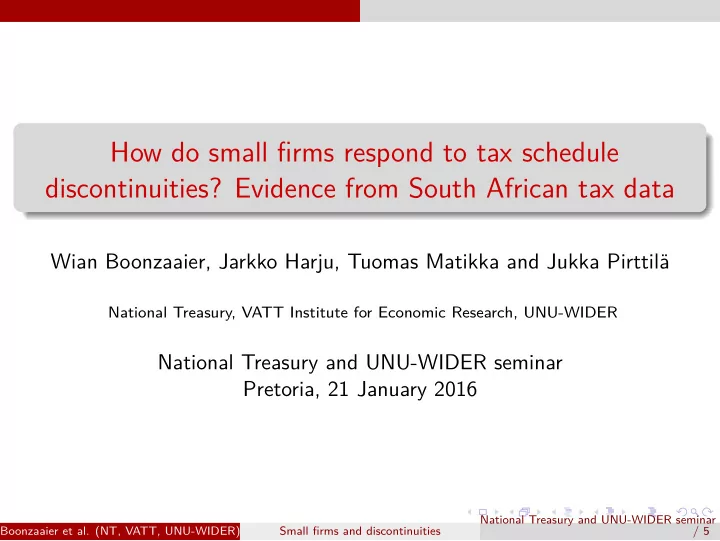

How do small firms respond to tax schedule discontinuities? Evidence from South African tax data Wian Boonzaaier, Jarkko Harju, Tuomas Matikka and Jukka Pirttilä National Treasury, VATT Institute for Economic Research, UNU-WIDER National Treasury and UNU-WIDER seminar Pretoria, 21 January 2016 National Treasury and UNU-WIDER seminar Preto Boonzaaier et al. (NT, VATT, UNU-WIDER) Small firms and discontinuities / 5
Background The purpose of this study Very little evidence exists on the impact of taxes on small firm behaviour in South Africa This paper endeavours to establish the causal impact of small business tax and value-added tax on SBCs We utilise bunching analysis to demonstrate how firms cluster around the different SBC income tax rates and the VAT registration threshold We focus on two types of behavioural effects: kinks (where the marginal income tax rate increases) and notch points (where the average tax rate jumps) National Treasury and UNU-WIDER seminar Preto Boonzaaier et al. (NT, VATT, UNU-WIDER) Small firms and discontinuities / 5
Background The method in more detail Main data source: SARS company tax database for 2010-2013 To only obtain entities registered for the SBC regime, we filtered the main database for: Legal entity status (foreign entities don’t qualify) Shareholders need to be natural persons Gross income limitation (<20 million rand) Limitation on shares held by shareholders, investment income, income from personal services For the VAT, we examine bunching around the VAT notch of one million rand without restricting the sample We then compare the behavioural kink and notch effects against a ’counterfactual’ density (i.e. what the firm distribution should look like in the absence of changes in tax incentives) National Treasury and UNU-WIDER seminar Preto Boonzaaier et al. (NT, VATT, UNU-WIDER) Small firms and discontinuities / 5
Background Preliminary results We find that small firms react strongly (i.e. change behaviour) to the SBC graduated income tax schedule and the VAT registration threshold Elasticity estimates of the CIT are large (especially upper threshold), but smaller for VAT In ongoing work, we will concentrate on the anatomy of the response: Is it real economic behaviour or avoidance that explains the observed clustering (outcome has policy implications) What are the implications for firm growth (Are companies holding back growth for tax purposes?) Caution should be exercised in the interpretation of the results National Treasury and UNU-WIDER seminar Preto Boonzaaier et al. (NT, VATT, UNU-WIDER) Small firms and discontinuities / 5
Background An example of results: lower kink of SBC regime Graph shows how firms cluster below first SBC marginal tax rate Vertical axis shows number of firms in each income interval, and horizontal axis show distance (in R’000) from the kink The counterfactual is represented by the dotted lines, and illustrates how firms ’should’ behave in the absence of the tax incentive Lower kink, 2010−2013 Excess mass: 4.69 (.508), Elasticity: .745 (.081) 4000 3000 Frequency 2000 1000 0 −50 −40 −30 −20 −10 0 10 20 30 40 50 Distance from the kink Observed Counterfactual National Treasury and UNU-WIDER seminar Preto Boonzaaier et al. (NT, VATT, UNU-WIDER) Small firms and discontinuities / 5
Recommend
More recommend